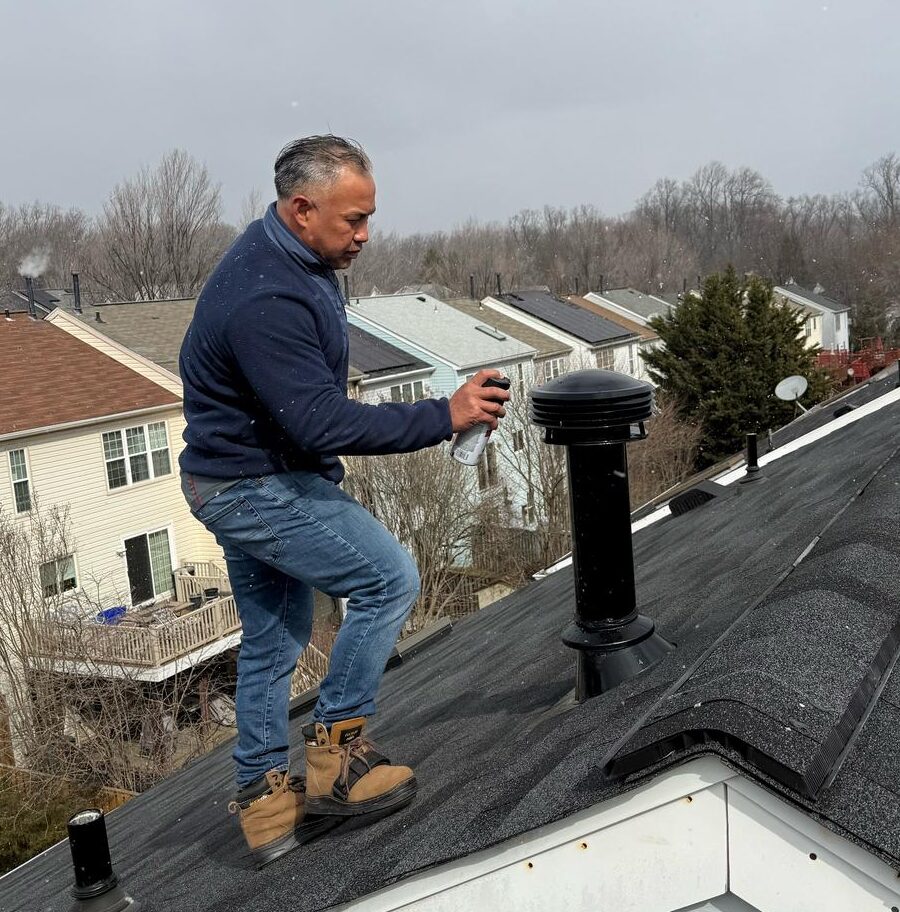
ROOF REPLACEMENT COSTS EXPLAINED
The roof replacement cost depends on various factors that can’t always be easily summed up with an online roofing calculator.
Investing in a new roof helps protect your home from the elements and can save you money on energy bills or numerous repairs and boost curb appeal and overall value.
You can read on to learn more about 15 key factors that impact the cost of replacing your roof.
15 KEY FACTORS THAT IMPACT THE COST OF A NEW ROOF
Every roof is unique and requires a trusted, professional roofing contractor to thoroughly inspect and provide an estimate specific to your roof’s needs.
While you might want to multiply the size of your roof by an estimated number for the cost of roofing materials and labor, this is an oversimplified calculation that leaves out many critical factors that can impact the total cost of your roofing project.
1. Roof Size
The size of your home’s roof directly impacts its replacement cost. The more surface area you must cover, the more materials you need, including OSB/plywood, underlayment, and shingles.
2. Roof Square Footage
The square footage of your home is not the same as the square footage of your roof, although you can use that figure as a starting point.
Your home’s square footage, frequently listed during a sale or appraisal, is a sum of all gross living areas. It includes each house level with multiple stories but usually doesn’t account for garage space, basements, and interior walls.
The roof square footage, on the other hand, includes all covered living spaces along with:
- Garages
- Walkways
- Overhangs
- Lanais, and
- Front entryways
You can get a rough idea of how large your roof is in square feet by multiplying the length (in feet) by the width (in feet) of all flat planes and adding them together. All measurements should run to the edge of each surface to include any areas that jut out beyond the side of the house (like eaves or overhangs).
3. Roof Slope
Remember learning how to calculate rise over run in junior high math class? Roof slope is a real-life opportunity to do a rise-over run calculation to figure out your roof’s incline or slope.
Residential roofs may have steep slopes, low slopes, or a combination. Roof slope is expressed as a ratio or fraction indicating how many inches the roof rises vertically for every 12 inches it runs horizontally (rise/run).
For example, a roof with a 10/12 (or 10:12) slope is much steeper than a 4/12 (or 4:12) slope.
Generally, the steeper the roof, the more expensive the project cost, typically due to safety reasons. For instance, a very steep roof might require special equipment for the roofers to use while they work on it.
4. Roof Slope Factor
The slope factor of the roof also contributes to the total square footage. You can determine the slope factor with the aid of a calculator, but roofing contractors typically have slope factor charts that simplify the process.
Knowing your roof’s slope, you can find the slope factor using a table or online calculator. If you’re measuring the roof square footage from the ground, a pitch factor must be added.
5. Waste Factor
Roofing contractors typically add 10-15% to the total roof square footage to account for waste factor, but this calculation can vary based on roof style or roofing materials. In roofing, waste factor accounts for material overlapped in valleys & hips, as well as cut-off material around flashings, penetrations, and gable ends.
6. Roofing Squares
When you work with roofing contractors, you may hear the term “squares” being discussed as part of roofing material estimates.
Roof surfaces are measured in squares. A roofing square is an area of your roof that equals 100 square feet and covers a 10’ x 10’ area. The number of roofing squares needed for a project is calculated by dividing the total roof area by 100 (1 yard).
For example, if your roof covers a 2200 square-foot area, divide 2200 / 100 = 22, so your project would require 22 squares of shingles to protect your roof.
7. Roofing Materials
The type of roofing shingles and materials you choose, or may even be required to have installed based on your geographical location and local building codes or HOA rules, will also impact the cost of getting a new roof. For example, traditional three-tab shingles may not cost the same as architectural shingles that meet COOL roof code requirements.
In addition to shingles, you may also need to replace or install new:
- Decking
- Underlayment
- Vents
- Flashing around chimneys, skylights, or roof-to-wall transitions, for example
Products within these categories vary in cost due to their differences in materials, performance, warranties, design or look, and other factors. For example, a roll of synthetic underlayment typically costs more than felt because it is a higher-quality product and covers far more area than a felt roll.
Depending on the type of roof shingles you choose for your home, a roofing contractor may need to follow special application instructions and use specific types of roof components to meet warranty requirements. For example, our Berkshire®, Woodmoor®, and Woodcrest® collections have special application instructions and require particular components to satisfy warranty requirements.
8. Roofing Design and Shape
A roof’s architectural style or design will also impact the cost of re-roofing. For instance, your roof might have a steep A-frame, multiple dormers, or a combination of gables and valleys.
A roofing contractor will likely consider the architectural design when providing a roof replacement cost estimate, and you might hear them refer to your roof as “cut-up” — meaning the roof has a more complex construction.
9. Condition of the Existing Roof
If you need a total roof replacement because your existing roof is heavily damaged, this may also affect the cost.
For example, if your roof has a hole that requires work on the underlying wood structure, this involves extra labor and materials. Water may have seeped into your attic and upper floors, causing damage that needs to be repaired.
In general, minor roof damage may not be expensive, but significant roof structural damage is likely much costlier.
Other Factors to Consider in Roof Replacement Costs
10. Geographical Area
The area of the U.S. where you reside also affects your roofing costs. This is primarily because the cost of materials and hourly labor rates differ among geographical regions.
For example, a roof replacement on the West Coast might not cost the same as a similar job in New England. Additionally, certain areas, such as California and Florida, have specific material and installation requirements to comply with state and local energy and building codes.
11. Local Building Permits and Inspections
Many communities require building permits for roofing installation, which must be obtained from municipal authorities. These fees should be factored into an estimate.
In some areas, many inspections occur as the installation progresses, which may add time and cost to the roofing project.
12. Roofing Contractor Rates
Roofing contractors typically charge an all-in price per square for a roofing project. This price should include labor and the cost of materials.
To determine whether rates are reasonable, ask for and compare estimates from several roofing companies in your area and talk to neighbors, friends, or family who may have had roof work done recently.
13. Material Disposal Fees
If your roofing project involves removing and disposing of existing roofing materials, then your contractor may add disposal fees to the total cost of the job. If the job is big enough, this might involve a dumpster rental or a general materials disposal fee.
14. Extended Warranties
Some roofing manufacturers may offer extended warranties for the customer to purchase separately from the standard roofing materials warranty that automatically comes with the products, which can add to the project’s overall cost.
15. Ventilation
If it’s determined that your roof lacks adequate ventilation, installing new vents may impact your roofing project’s costs and timeline. Use our ventilation calculator to estimate your minimum ventilation requirements.
– Roof Repair vs. Roof Replacement
When your roofing contractor evaluates your project and provides an estimate, they will likely let you know whether or not you need a roof repair.
Some things that might affect their decision include:
- Age of roof
- Existing roof leaks
- The extent of roof damage, such as if the damage is aesthetic or structural
- Geographical area
Minor or Moderate Damage: Roof Repair
Partial reroofing or repairs may be an option if the physical damage to your roof is mild or moderate. For example, wind damage may have removed several shingles from a particular area of your roof, or perhaps the damage is more reasonable but confined to one side of a roof instead of widespread.
In both cases, a roof repair or partial reroof project will likely cost less than a total roof replacement.
More Significant Damage: Roof Replacement
Suppose your roofing contractor finds in their evaluation that the damage to your home’s roof is more extensive and involves critical structural components. In that case, getting an entirely new roof might make more sense.
A complete roof replacement may help you avoid further damage and costlier repairs. Getting a new roof helps protect your home and your peace of mind – and you’ll be able to choose a shingle style and color of your choice rather than simply trying to match existing materials.
THE BOTTOM LINE
Even if you’ve set the money aside to invest in your home, you may wonder if you have enough saved. Can you afford a new roof? Provided that a roof protects your home, family, and belongings, the question is, can you afford not to get a new roof? The only way to truly determine how much your roofing project will cost is to get an estimate from a contractor.
- Roofing costs can vary regarding roofing projects, whether it involves a repair or a complete roof replacement.
- Online roofing calculators can help you estimate costs based on the approximate size of your roof, the material types, and other factors. Still, they are incomplete—you need an accurate quote from a roofing contractor.
- You should get multiple estimates—you don’t need to go with the first contractor you call. Be sure that all appraisals are an apples-to-apples comparison; otherwise, what looks like a good deal might be cutting corners. Be aware of contractors with significantly lower rates. This could be a red flag that something was missed in the estimate, resulting in change orders costing you more in the long run.

